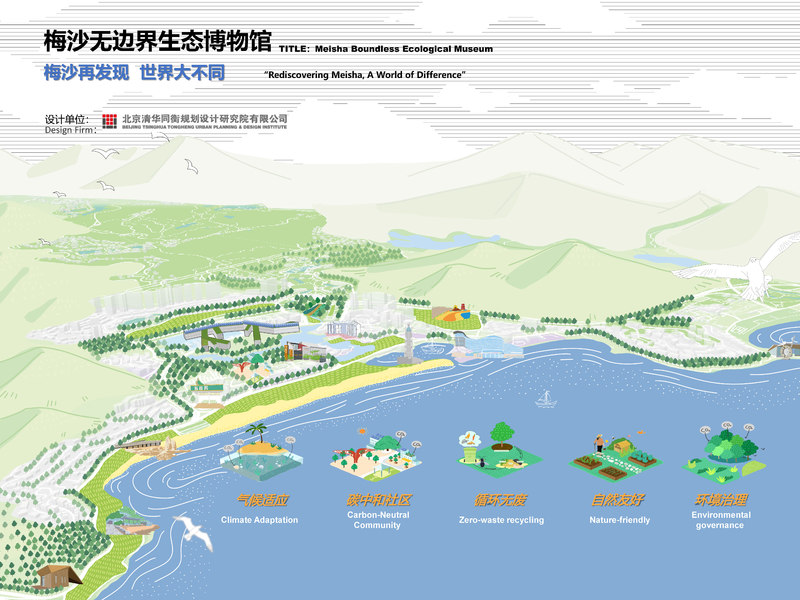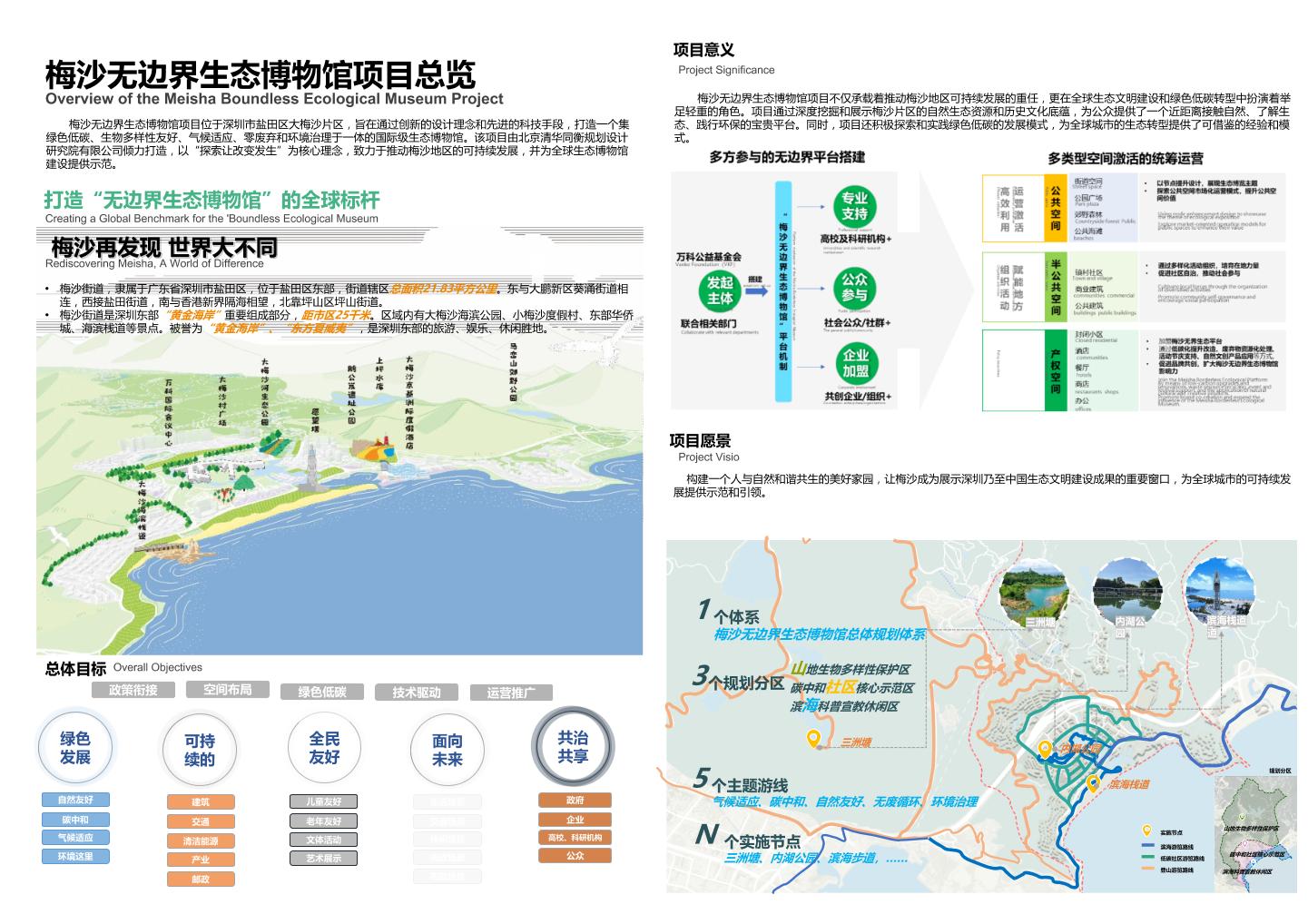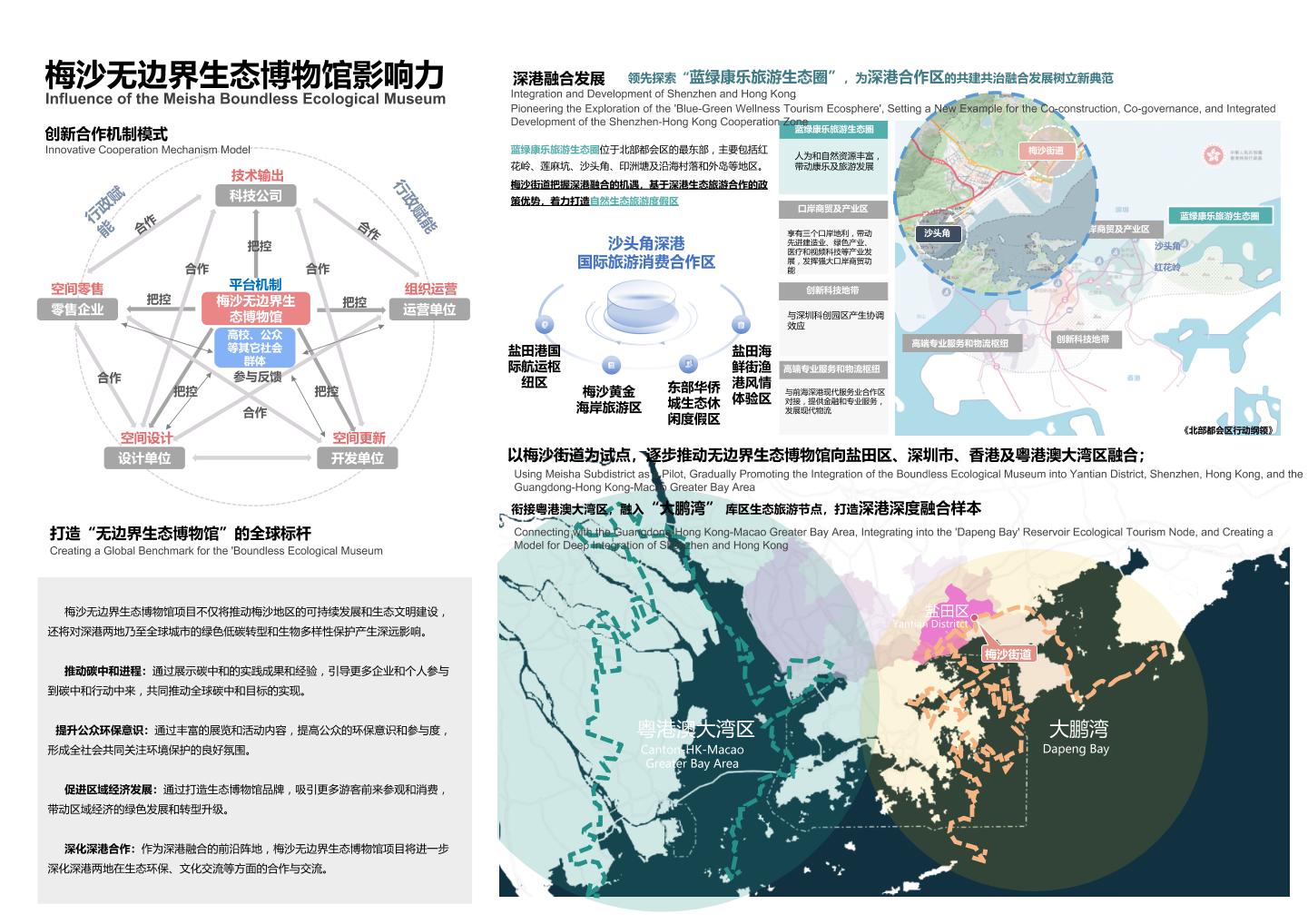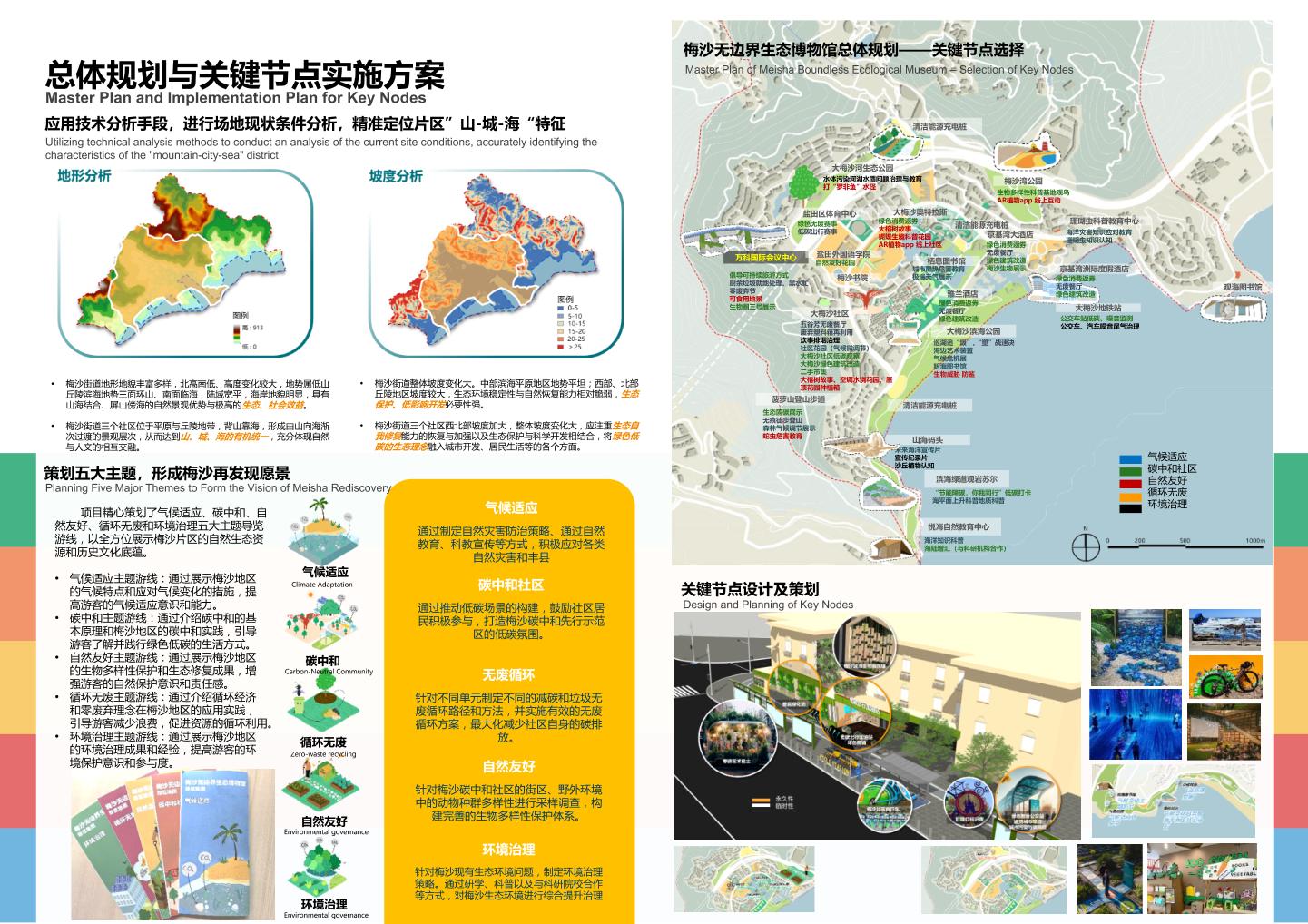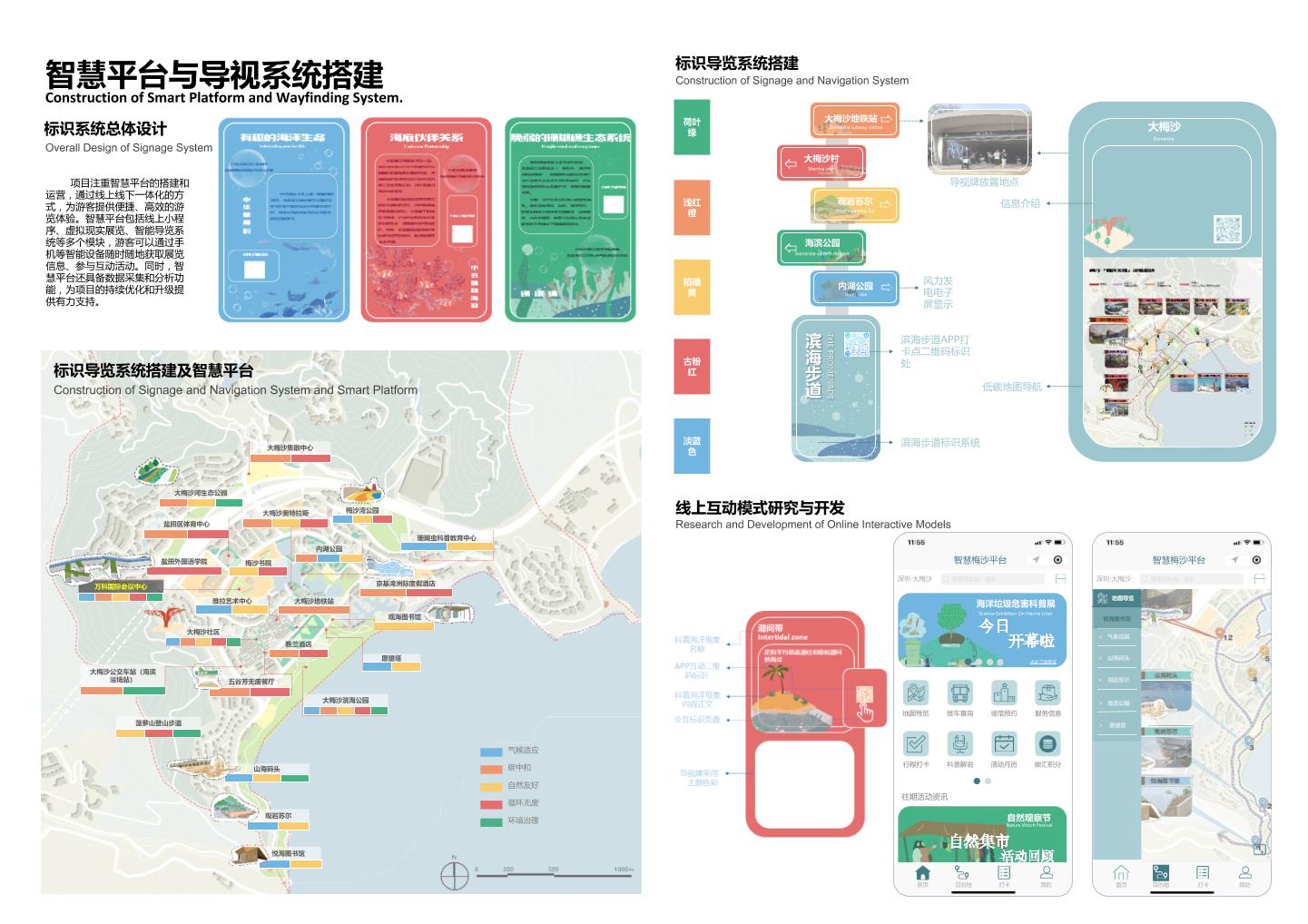Detailed Introduction of Shenzhen Meisha Borderless Ecological Museum Project
The PPT document gives a detailed description of the project, emphasizing the technical means of current situation analysis, overall planning strategy, five major theme planning and guided tour routes, intelligent platform construction and the influence of the project in the integrated development of Shenzhen and Hong Kong, the Greater Bay Area and international sustainable development. Among our many creative practices, the Meisha Borderless Eco-Museum project is undoubtedly a landmark work. This project is located in Dameisha area, Yantian District, Shenzhen. We have made full use of the unique spatial pattern of Shanhaicheng village and rich natural ecological resources in this area. Through innovative design concepts and advanced scientific and technological means, we have created an international ecological museum integrating green, low-carbon, biodiversity friendly, climate adaptation, zero waste and environmental governance. As China's first borderless eco-museum on a community scale, the project builds a new paradigm of co-governance and sharing by the government, enterprises and residents through the triple innovation of space borderless, operation socialization and education scene. Its core value is to transform ecological protection into perceptible and participatory daily life practices, making Meisha a "dynamic showcase" for displaying the construction of ecological civilization, and providing a "Chinese sample" for the sustainable development of global cities ".
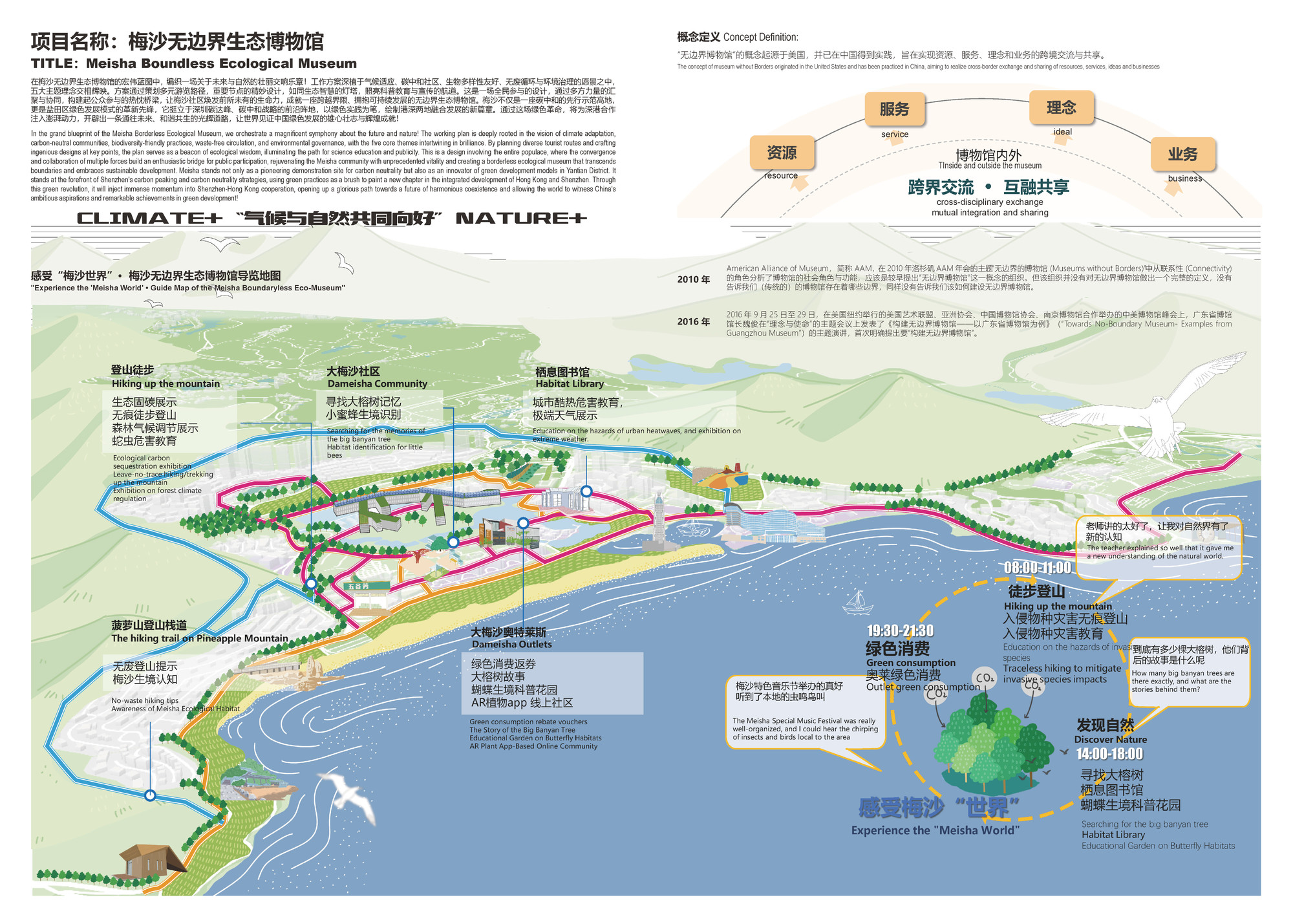
1 Overview of Meisha Borderless Ecological Museum
The Meisha Borderless Ecological Museum takes "Meisha rediscovered, the world is very different" (Exploration Makes Difference) as its core concept, relies on the 7 square kilometers core area of Dameisha community, and links with the surrounding communities to build an ecological museum experience network that breaks through the traditional boundaries. The project takes Vanke Center as the strategic starting point, and builds the world's first "borderless ecological museum" around the five themes of climate adaptation, carbon neutrality, nature friendliness, recycling without waste, and environmental governance. It organically connects public spaces such as streets, squares, parks and urban villages, commercial buildings, hotels and other semi-public and property spaces to form a three-dimensional ecological display scene. Through the transformation of node space, market-oriented operation and community co-creation mechanism, the deep integration of ecological value and urban life is realized.
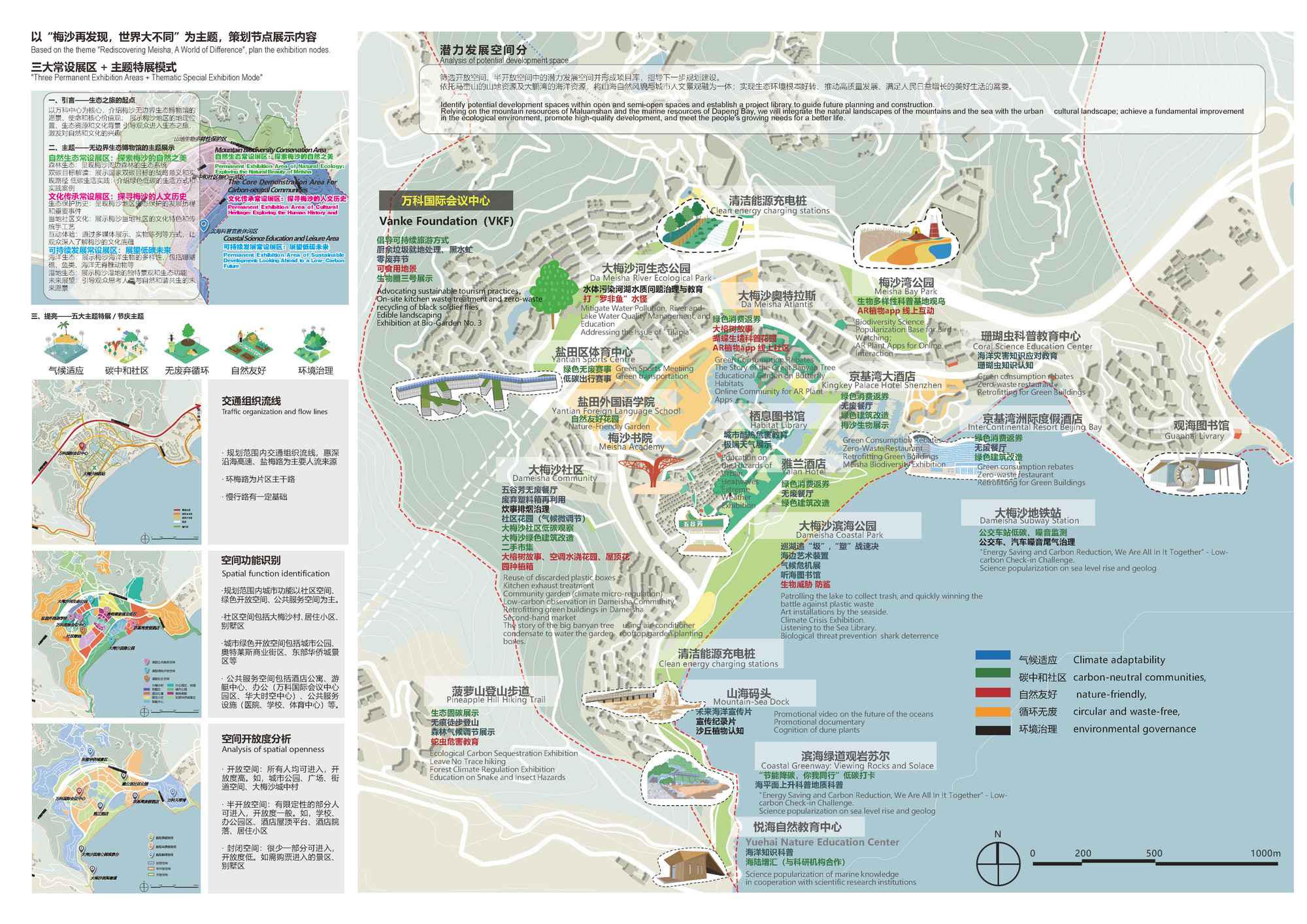
2 Key Nodes and Analysis of Meisha Borderless Ecological Museum
In terms of spatial planning and design, the project creatively puts forward the concept of "borderless eco-museum", and the Vanke Public Welfare Foundation and multiple institutions build a collaborative network to attract professional teams, scientific research institutions and the public to participate. Relying on the unique mountain and sea resources of Meisha, five theme tour routes covering more than 20 scenes, such as coastal park, natural education center and ecological park, have been constructed. Among them, the climate adaptation route reveals the wisdom of climate change response through the Guanyansul geological observation point, the carbon neutral route is implanted with zero-carbon life interaction devices in scenes such as Dameisha subway station, and the natural friendly route establishes a deep connection between human beings and biodiversity through mountain forest exploration activities. Particularly prominent is the cycle of waste-free theme, the Meishawan Park to build the country's first "waste-free park" demonstration model. The operating system adopts the "all-season flexible model" and designs three-day in-depth study tour products and modular nature education courses. Plant observation is carried out along Yanmei Road in spring, carbon neutral science and technology exhibition is carried out in Vanke International Conference Center in summer, and ecological restoration practice of mountain and sea is organized in autumn and winter.
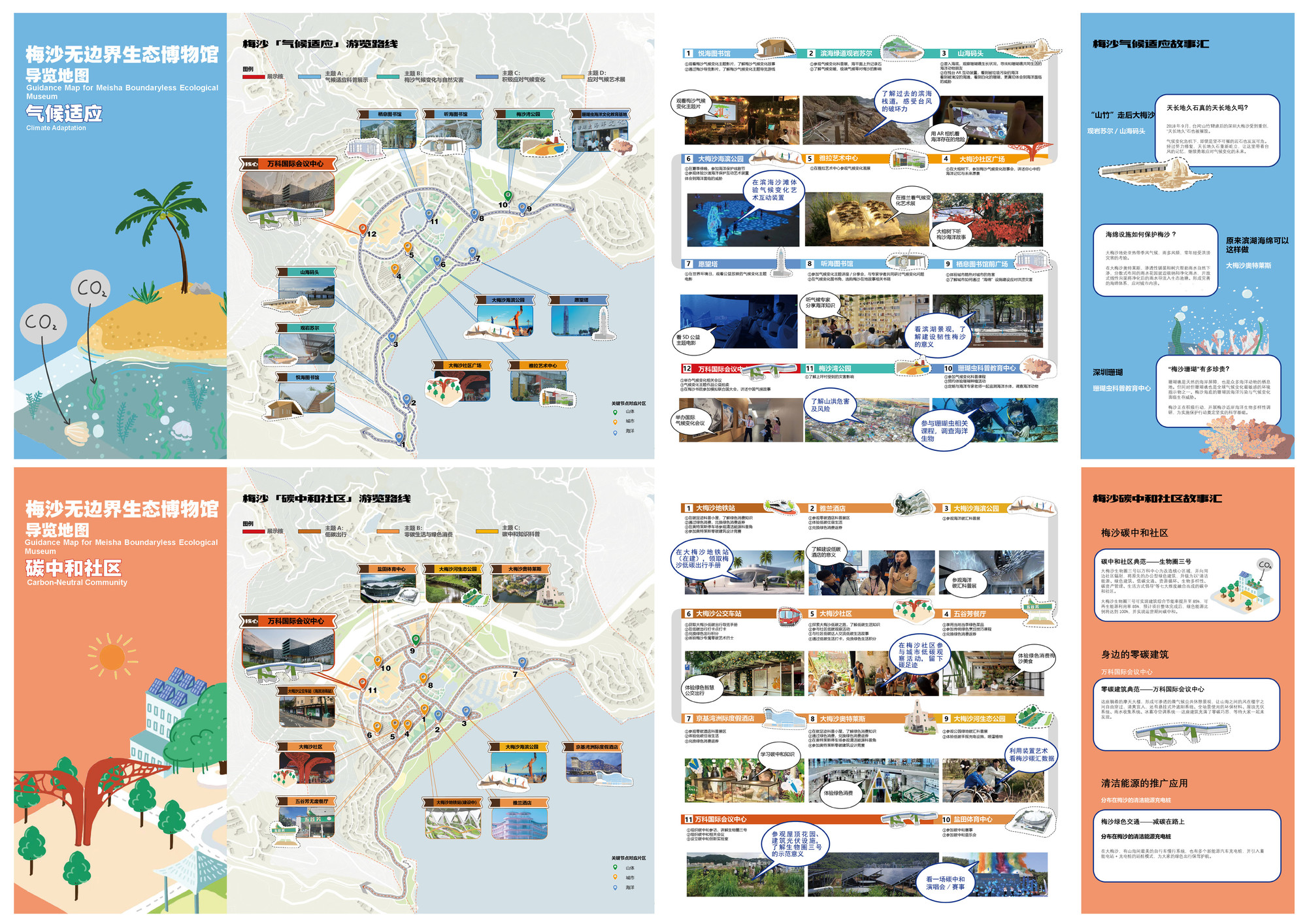
3 Five major theme guide map and planning
The overall planning and design of Meisha Borderless Ecological Museum builds a "theme-driven space network" by accurately matching the five theme features and scene function requirements ". In the theme of climate adaptation, the following contents are planned and planned: Guanyan Sul geological observation site is selected as the core node due to its unique sea erosion landform-the exposed rock section becomes the natural annual ring of climate change, and tourists can observe the erosion traces of the rock layer caused by sea level rise in the past hundred years through augmented reality equipment; while Dameisha Binhai Park is designed with flexible design such as lifting plank road and salt-resistant plant community, transforming climate adaptation technologies into experiential "classrooms by the sea". The space planning and planning of the theme of carbon neutrality focus on the transportation hub and energy node with dense flow of people: the solar photovoltaic glass laid on the roof of Dameisha subway station and the real-time carbon footprint calculation screen in the station form a visual closed loop of "production-consumption"; The three-dimensional vertical forest curtain wall of Vanke International Conference Center not only realizes the carbon neutrality of the building itself, but also becomes a micro ecosystem observation station, the 12 species of insects inhabiting in its vine grid are designed as dynamic biological indicators, visually reflecting the quality of the environment.
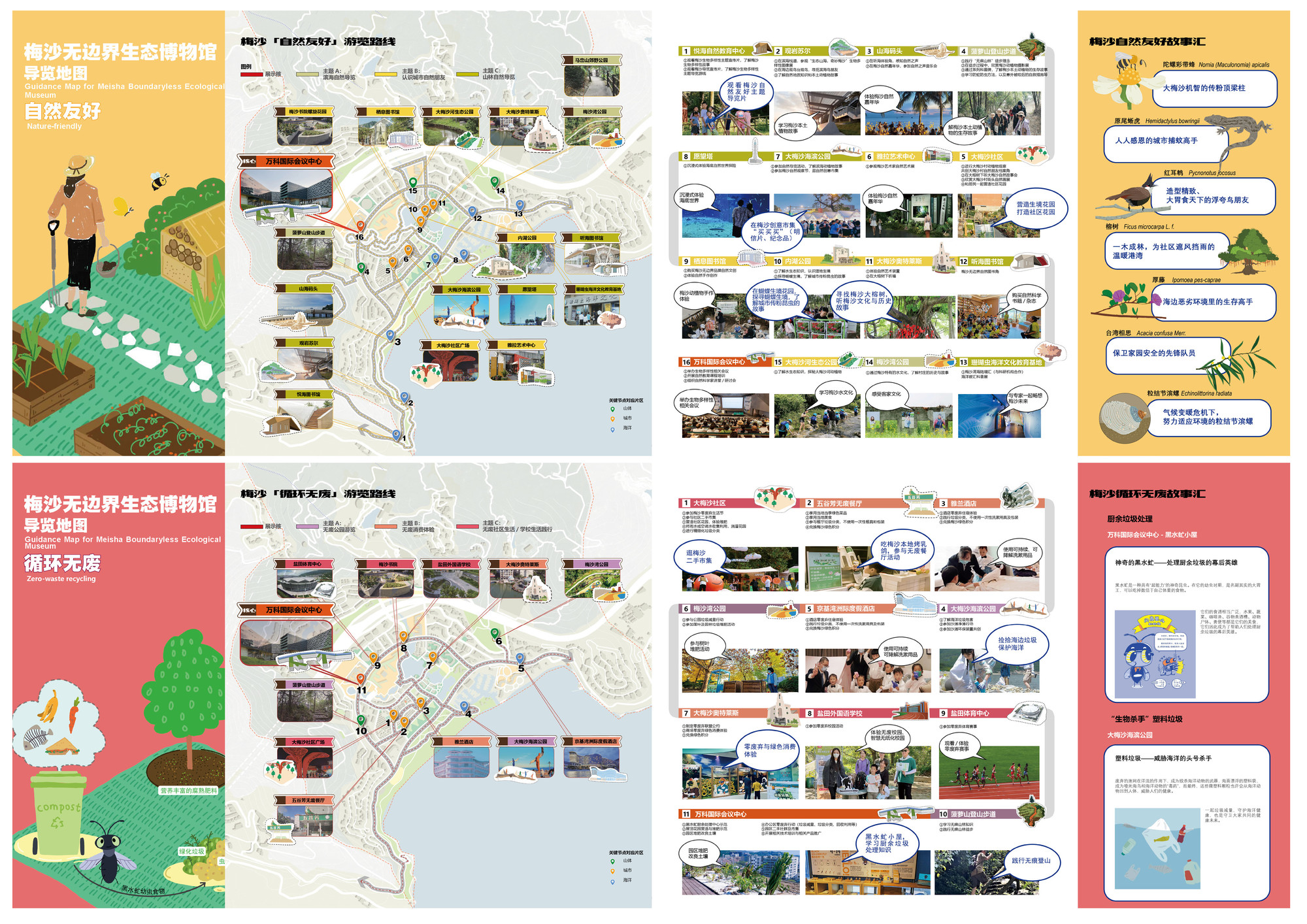
4 five major theme guide map and planning
The space layout planning of nature-friendly theme combines the spatial structure of seashore, city and mountain, and carries out the following planning and planning contents. The ecological floating island of Neihu Park and the mangrove conservation area of Yuehai Nature Education Center are connected by ecological corridors to form a "city station" for bird migration ". The design team plans to implant local nectar plant belts on the slope of Yanmei Highway to make 2.3 kilometers of roads "highways" for pollinating insects. Vibration sensors set at nodes can collect insect activity data and generate acousto-optic interaction devices. The space innovation of recycling and waste-free theme is embodied in the "metabolic closed-loop" planning: the following contents are specifically planned: the wave-shaped recycling pavilion in meishawan park integrates the garbage sorting box with the rest seat, and uses the landscape device printed by recycling plastic 3D to display the community garbage conversion rate in real time; The "Waste-Free Consumption Test Site" in Dameisha Community Commercial Street traces the commodity life cycle through code scanning, its circular streamline design guides visitors from the consumer end back to the production end, forming a spatial metaphor of the material cycle.
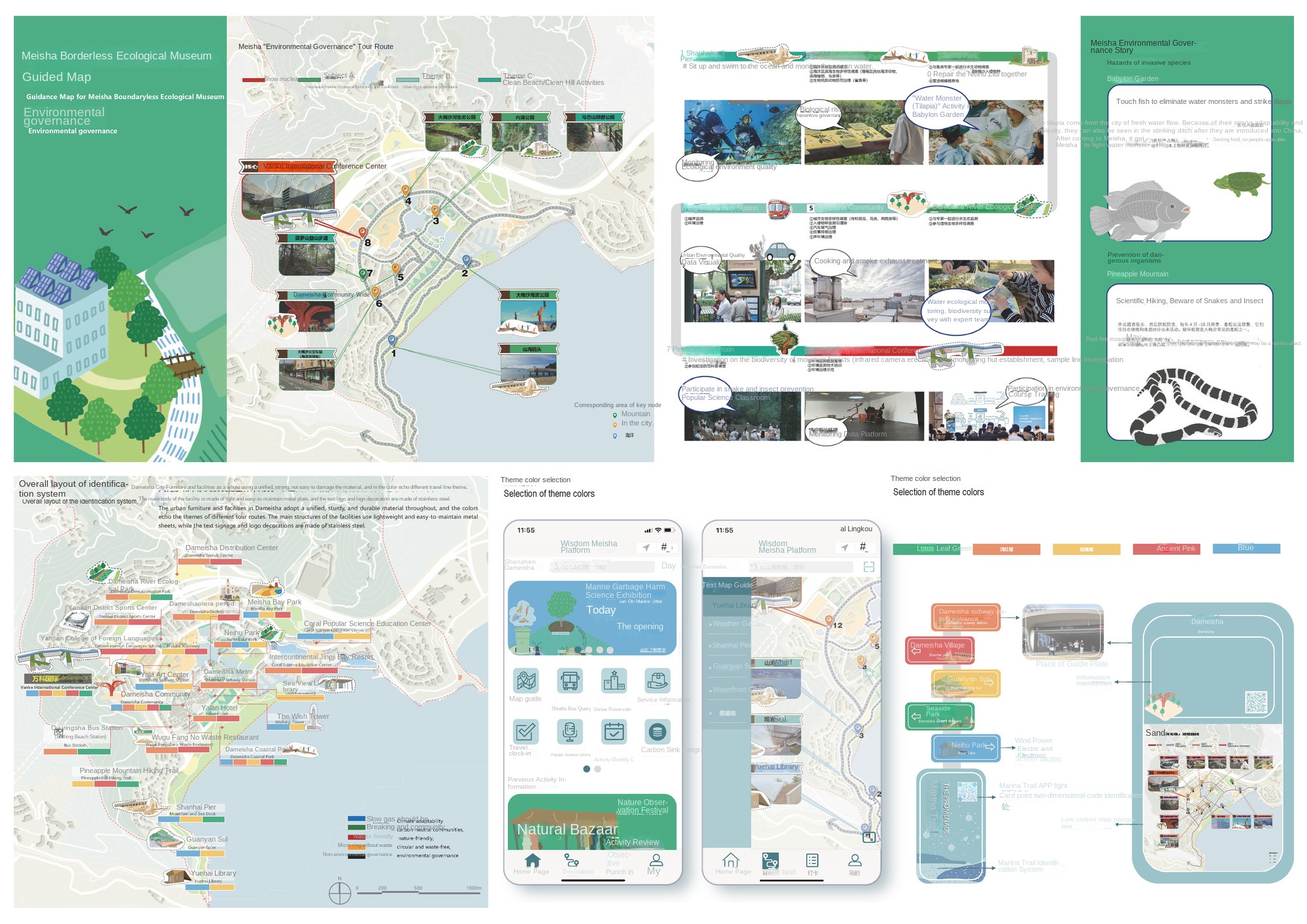
5 Construction of intelligent platform and logo navigation system
The node selection of the theme of environmental governance emphasizes "problem visualization" and specifically plans the following contents: the freshwater ecological monitoring station in Babylon Park displays the whole process of sewage treatment with a transparent pipe gallery, and the art device of pollutant particles suspended in the air is linked with real-time water quality monitoring data to change color; The landslide control area of Meisha Ecological Park has been transformed into a stepped rain garden, and the exposed anchor structure has been artistically wrapped into a popular science exhibition of geological stability. The five theme spaces are connected by a unified "ecological ribbon" identification system. The ground guide uses degradable fluorescent materials to present a flowing luminous path at night, which is a metaphor for the energy flow of the ecosystem. The project focuses on the construction and operation of the smart platform, and provides tourists with a convenient and efficient tour experience through the integration of online and offline. The smart platform includes multiple modules such as online applets, virtual reality exhibitions, and smart navigation systems. Visitors can obtain exhibition information and participate in interactive activities anytime and anywhere through smart devices such as mobile phones. The smart platform also has data collection and analysis functions, which can collect tourists' behavior data and feedback in real time, and provide strong support for the continuous optimization and upgrading of the project. Through these data, the project team can understand the needs and preferences of tourists, and then adjust the exhibition content and navigation methods to improve the satisfaction of tourists. The logo navigation system closely cooperates with the intelligent platform, connecting the entity logo with online information through two-dimensional code and other means. Visitors only need to scan the two-dimensional code on the logo to obtain relevant exhibition information and navigation services. This combination not only enriches the tourist experience, but also reduces the production and maintenance costs of the entity logo.
The Meisha Borderless Ecological Museum project is located in Dameisha District, Yantian District, Shenzhen. It aims to build an international ecological museum integrating green and low-carbon, biodiversity-friendly, climate adaptation, zero waste and environmental governance. The project takes "Meisha rediscovered, the world is very different" as the core concept, and is committed to building the Meisha area into a benchmark project for global sustainable development.
Meisha area has rich natural resources and unique spatial pattern of mountain and sea city village. The diversified ecological landscapes such as ocean, mountain and urban green space in the area, as well as the profound historical and cultural heritage, have laid a solid foundation and unique conditions for the implementation of the project. As the frontier of the integration of Shenzhen and Hong Kong, the unique geographical location and policy advantages of the Meisha area also provide a broad space for the international development of the project.
The project design takes green and low-carbon, biodiversity-friendly, climate adaptation, zero waste and environmental governance as the core concepts. Through innovative planning and design and event planning, the Meisha area will be built into a collection of ecological display, popular science education, cultural exchanges, A comprehensive ecological museum integrating leisure experience. The project focuses on the multi-dimensional expansion of space and the all-round improvement of services, and realizes the borderless expansion of the eco-museum through the deep integration of online and offline.
The overall planning strategy of the project includes four aspects: time planning, space planning, mechanism planning and activity planning. In terms of time planning, the overall goal of the project is to implement the Meisha Borderless Ecological Museum in 2027, and to clarify the key tasks of each stage. In terms of spatial planning, the project connects the Guangdong-Hong Kong-Macao Greater Bay Area and integrates into the eco-tourism node of the "Dapeng Bay" reservoir area to create a sample of deep integration between Shenzhen and Hong Kong. In the mechanism planning, the establishment of multi-party participation in the service mechanism. In the event planning, the project combines five themes to plan a variety of guided tours and activities.
The project plans five thematic guided tours of climate adaptation, carbon neutrality, nature friendliness, recycling without waste and environmental governance. Through these five theme tours, we can deeply understand the natural ecological resources and historical and cultural heritage of Meisha area, and experience the green and low-carbon lifestyle and environmental protection concept. Each tour line has carefully designed multiple nodes and interactive links, so that tourists can fully feel the charm of the ecological museum during the tour.
The project pays attention to the construction of intelligent platform, and realizes the intelligent management and service of ecological museum through the integrated operation mode of online and offline. The smart platform includes online applets, virtual reality exhibitions, intelligent navigation systems and other modules to provide visitors with a convenient and efficient tour experience.
The Meisha Borderless Ecological Museum project will not only promote the green development of Yantian District and improve the regional environmental quality, but also further enhance the cultural exchanges and cooperation between Shenzhen and Hong Kong. The project will also provide useful exploration and reference for the sustainable development of Shenzhen and even the Guangdong-Hong Kong-Macao Greater Bay Area. With its unique design concept, rich activity content and extensive international influence, Meisha borderless eco-museum project will become a leader in the field of global eco-museums. The project not only demonstrates Shenzhen's outstanding achievements in green, low-carbon and biodiversity conservation, but also provides valuable experience and enlightenment for the sustainable development of global cities.
Tsinghua Tongheng Eco-City Research Institute, as a professional institution focusing on eco-city construction and biodiversity protection, has been committed to promoting the harmonious coexistence of cities and nature through scientific planning and innovative design. Our business covers a wide range of fields, including ecological city construction, biodiversity friendly protection, popular science education, wetland protection and restoration, comprehensive implementation of guiding projects and urban renewal design. Over the years, our projects throughout the country and even the Middle East, has accumulated a wealth of practical experience, and won a number of awards in the industry, has been widely recognized.
In our creative practice, we always uphold the concept of respecting nature, conforming to nature, and protecting nature, and integrate ecological elements into urban planning and design. We take the link between city and nature as the core, through the restoration and protection of biodiversity, improve the quality and stability of urban ecosystem, and provide a more livable living environment for urban residents.
In the project, we also actively promote the construction of ecological communities such as community gardens, emphasize all-age friendliness, encourage residents to participate in co-construction, and let the green ecological concept take root in the hearts of the people and https://mp.weixin.qq.com/s/yxbKNVcc8H_3XGain7FBAg/ https://mp.weixin.qq.com/s/bAT7Uvu19RzEnSOViSJy4w 。. https://mp.weixin.qq.com/s/2v6FhkwRHiU9T0mZTrMkkw,通过责任规划师工作,扎根密云,推动密云观鸟小镇项目建成开放。 in the planning and implementation project of Miyun Beizhuang Bird Watching Town Through the planning and application of scientific restoration methods, such as the protection and restoration of the wetland on Shihe Henan Island, it not only protects the forgotten bird paradise, but also provides urban residents with a valuable opportunity to get close to nature and understand ecology.
Our work is closely related to Chinese design, society, environment or culture. In terms of design concept, we pay attention to the integration of Chinese traditional cultural elements, such as learning from China's ecological wisdom to achieve a global model of sustainable development. We emphasize the holistic view of harmonious coexistence between man and nature, innovate protection ideas and mechanisms, and actively seek new ways for harmonious coexistence between man and nature in protecting the vast urban and rural areas outside the ground. Focus on Special Ecological Planning and https://mp.weixin.qq.com/s/2v6FhkwRHiU9T0mZTrMkkw,分析气候变化对片区所带来的潜在危害,强调韧性发展,科学认知片区地形以及气候等特征,分析片区潜在风险,对片区典型资源进行有效认知。 of Shalang Area in Wuhua District of Kunming City We emphasize that at the social level, we promote the public's environmental awareness and ecological literacy through popular science education and cultural exchange activities, and promote the green development of society. At the environmental level, we are committed to restoring and protecting biodiversity, improving the quality and stability of urban ecosystems, and contributing to the response to global climate change and the decline of biodiversity.
Tsinghua Tongheng Eco-City Research Institute is a first-class professional institute of Beijing Tsinghua Tongheng Planning and Design Research Institute Co., Ltd. Our business scope is extensive, covering eco-city construction, biodiversity-friendly protection, popular science education, wetland protection and restoration, Guide the comprehensive implementation of projects and urban renewal design, urban planning and ecological research and consultation at all stages of urban design. Our services promote the harmonious coexistence of cities and nature through scientific planning and innovative design. Our projects throughout the country and the Middle East, has accumulated a wealth of practical experience, and won a number of awards, has been widely recognized.







